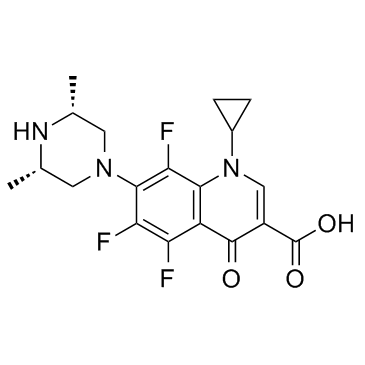Orbifloxacin

Orbifloxacin structure
|
Common Name | Orbifloxacin | ||
|---|---|---|---|---|
| CAS Number | 113617-63-3 | Molecular Weight | 395.376 | |
| Density | 1.4±0.1 g/cm3 | Boiling Point | 590.7±50.0 °C at 760 mmHg | |
| Molecular Formula | C19H20F3N3O3 | Melting Point | 260 °C(dec.) | |
| MSDS | Chinese USA | Flash Point | 311.1±30.1 °C | |
|
Simultaneous determination of 38 veterinary antibiotic residues in raw milk by UPLC-MS/MS.
Food Chem. 181 , 119-26, (2015) A selective and rapid method has been developed to determine, simultaneously, 38 veterinary antibiotic residues in raw milk by ultra-high-performance liquid chromatography-tandem mass spectrometry (UPLC-MS/MS). One milliliter of raw milk was diluted with 0.5 ... |
|
|
Multi-residue Determination of Polar Veterinary Drugs in Livestock and Fishery Products by Liquid Chromatography/Tandem Mass Spectrometry.
J. AOAC Int. 98(1) , 230-47, (2015) Residues of 37 polar veterinary drugs belonging to six families (quinolones, tetracyclines, macrolides, lincosamides, sulfonamides, and others) in livestock and fishery products were determined using a validated LC-MS/MS method. There were two key points in s... |
|
|
Development of a novel genetically modified bioluminescent-bacteria-based assay for detection of fluoroquinolones in animal-derived foods.
Anal. Bioanal. Chem 406(30) , 7899-910, (2014) Fluoroquinolones (FQNs) are broad-spectrum antibacterial agents widely used in animal husbandry and aquaculture. The residues and antimicrobial resistance of such antibiotics are a major public health concern. To realize multianalyte detection of FQN residues... |
|
|
The influence of sleep restriction on expression of apoptosis regulatory proteins p53, Bcl-2 and Bax following rat tongue carcinogenesis induced by 4-nitroquinoline 1-oxide.
J. Oral. Pathol. Med. 44(3) , 222-8, (2015) The aim of this study was to evaluate whether sleep restriction (SR) could affect the mechanisms and pathways' essentials for cancer cells in tongue cancer induced by 4-nitroquinoline 1-oxide in Wistar rats.The animals were distributed into 4 groups of 5 anim... |
|
|
Inhibition of miR-17 and miR-20a by oridonin triggers apoptosis and reverses chemoresistance by derepressing BIM-S.
Cancer Res. 74(16) , 4409-19, (2014) Cancer cell chemoresistance arises in part through the acquisition of apoptotic resistance. Leukemia cells resistant to chemotherapy-induced apoptosis have been found to be sensitive to oridonin, a natural agent with potent anticancer activity. To investigate... |
|
|
CD133⁺ melanoma subpopulation acquired resistance to caffeic acid phenethyl ester-induced apoptosis is attributed to the elevated expression of ABCB5: significance for melanoma treatment.
Cancer Lett. 357(1) , 83-104, (2014) According to the cancer stem-like cell (CSC) hypothesis, neoplastic clones are maintained by a small fraction of cells with stem cell properties. Also, melanoma resistance to chemo- and radiotherapy is thought to be attributed to melanoma stem-like cells (MSC... |
|
|
Exploring the anti-apoptotic role of HAX-1 versus BCL-XL in cytokine-dependent bone marrow-derived cells from mice.
FEBS Lett. 588(17) , 2921-7, (2014) HS-1-associated protein X-1 (HAX-1) is a multi-functional protein that has been implicated in the regulation of apoptosis, cell motility and calcium homeostasis. In the present study, we set out to assess the postulated functional resemblance of HAX-1 to the ... |
|
|
Inhibition of mast cell-derived histamine secretion by cromolyn sodium treatment decreases biliary hyperplasia in cholestatic rodents.
Lab. Invest. 94(12) , 1406-18, (2014) Cholangiopathies are characterized by dysregulation of the balance between biliary growth and loss. We have shown that histamine (HA) stimulates biliary growth via autocrine mechanisms. To evaluate the paracrine effects of mast cell (MC) stabilization on bili... |
|
|
In vitro selection of resistance to pradofloxacin and ciprofloxacin in canine uropathogenic Escherichia coli isolates.
Vet. Microbiol. 174(3-4) , 514-22, (2014) This study explored and compared the mechanisms and selective concentration of resistance between a 3rd (pradofloxacin) and 2nd (ciprofloxacin) generation fluoroquinolone. Pradofloxacin- and ciprofloxacin-resistant mutants were selected by stepwise exposure o... |
|
|
Loss of interleukin-21 receptor activation in hypoxic endothelial cells impairs perfusion recovery after hindlimb ischemia.
Arterioscler. Thromb. Vasc. Biol. 35(5) , 1218-25, (2015) Surgical hindlimb ischemia (HLI) in mice has become a valuable preclinical model to study peripheral arterial disease. We previously identified that the different phenotypic outcomes after HLI across inbred mouse strains is related to a region on the short ar... |